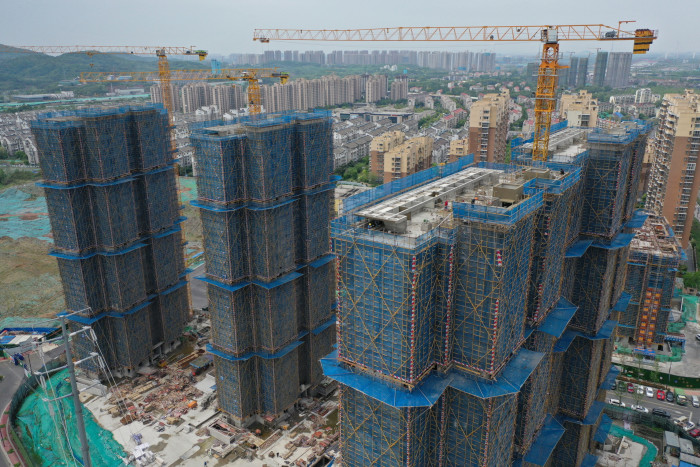
Lucy Wang finds herself at the sharp end of a crisis seeping through China’s property market. She once dreamt that buying an under-construction apartment in the northern city of Zhengzhou would be her ticket to a new life.
For a young woman from a farming village, the Rmb250,000 ($34,839) down payment she used to secure the property represented a big outlay. Half of the money had come from her parents, who had put aside years of meagre savings from selling the potatoes and wheat they grew on the family plot.
Everything seemed set fair until October last year, when building activity on her block of flats suddenly stopped. At first, she said, the developer of the Meiling International House was evasive on when construction might resume. Then its representatives started spouting reams of unlikely excuses.
In July Wang’s hope died. The local housing bureau told her and other buyers that their money had been “misused”. “I have lost faith in the developer,” she said. “This has ruined my life.”

Wang is a victim of China’s gathering economic gloom. A property market that has contributed around one quarter of GDP has over the past decade turned sour, triggering a series of secondary effects that are smothering growth in the world’s second-largest economy. Logan Wright, a Hong Kong-based partner at consultancy Rhodium Group, calls the situation a “slow-motion financial crisis”.
Contagion is spreading into the deep tissue of China’s political economy. What began as a property crisis — characterised by slumping apartment sales and a rash of debt defaults by developers — is now morphing into a financial crunch at the local government level.
A new world of difficult choices looms before Chinese policymakers as a crucial congress of the ruling Communist party this month looks set to award another term in office to Xi Jinping, China’s authoritarian ruler.
With the market slump, thousands of local government financing vehicles (LGFVs), which since the financial crisis have provided the main impetus behind China’s investment-driven growth, are either running short of funds or teetering on the brink of unprecedented defaults, analysts say. Local governments have long depended on land sales to property developers to balance their books.
Taken together, the slumping property market, the sputtering investment engines of local governments and a hefty burden of national debt signals the end for a model of growth that has not only transformed China but also been the biggest generator of global economic expansion for well over a decade.

Dan Wang, chief economist at Hang Seng Bank, a Hong Kong-headquartered bank with significant operations in mainland China, says the economy has arrived at an inflection point. “The old model of relying on infrastructure and housing has essentially finished,” she says.
One of the next twists, according to Wright, is likely to be unprecedented defaults by LGFVs on the domestic bonds they issue. If LGFVs do default, it will signal the crossing of a “Rubicon”, he says.
This is partly because these bonds — which have financed the construction of roads, railways, power plants, airports, theme parks and hundreds of other pieces of infrastructure — have been assumed to enjoy an implicit government guarantee. More materially, such defaults could also destabilise a $7.8tn mountain of debts built up by such LGFVs, sending chills through an already cooling economy.
To put it in context, that figure for LGFV debt is the equivalent of nearly half of China’s total GDP in 2021 — or, for example, about twice the size of Germany’s economy.
In the free markets of the west, financial crises can erupt suddenly, taking governments and investors by surprise. But in China’s state-driven economy, infirmities metastasise more slowly as Beijing deploys political and financial capital to battle against the turning tide. This gives proceedings a more stately aura, but it does not mean that underlying problems are any less severe, analysts say.
The global implications of a Chinese economic slowdown are stark. The country’s contribution to the world’s economy, already hit by a sharply slowing GDP growth rate this year, would be further enfeebled. Multinationals that derive much of their revenue growth from China may be forced to trim earnings projections.
“China’s growth model has run its course,” says Chen Zhiwu, professor of finance at the University of Hong Kong. He adds that in the past few years, Beijing has tried to stretch the booms in property and infrastructure in order to prolong investment-led growth.
“But now, all these drivers have little space left, if any at all.”
Three red lines
Wang’s travails reveal a crucial aspect of what is ailing the property market. She had bought a “presale property”, a type of investment that worked satisfactorily when apartment sales were buoyant and real estate prices were almost perpetually on the rise.
Under this model, buyers would hand over a down payment of typically 30 per cent of the value of an apartment. They would then start paying monthly mortgage instalments as the developer built the apartments from the ground up. If everything worked out, the buyer would take delivery of a new apartment on a certain date, happy in the expectation that it would be worth more than when construction began.
But several factors have conspired to undermine this cosy arrangement.
In August 2020, the Chinese government — spooked over the spectre of a debt-fuelled property bubble — imposed “three red lines” on developers to restrict their capacity to add to already giddy levels of debt. This, in turn, left some overleveraged developers without the means to finish apartment blocks they had already pre-sold.
As developer funds dried up, building activity on some apartment blocks petered out. In protest, hundreds of thousands of would-be apartment owners this year boycotted the mortgages they had pledged to pay on more than 300 developments in nearly 100 cities.
Wang was one such protester. She says she stopped paying the Rmb3,800 monthly mortgage instalment in June. In any case, it would have been difficult for her to afford the payments because her job as a sales agent for “baijiu”, an alcoholic drink, has been hit by China’s broader economic slowdown.
“I am not optimistic about the project,” Wang says. “I heard an executive at the developer has recently been arrested.”
Economic contagion
Personal misfortunes such as Wang’s reveal the human cost from a contagion that is starting to course through the main arteries of the Chinese economy.
“The next stage of the property crisis is the transmission of losses from property developers to China’s financial system,” says Wright, tracing a clear line of cause and effect from the current stalled real estate projects to local government debt distress, lower investment levels and finally to the possibility of emergency state bailouts.
Such transmission mechanisms are already in play.

The “three red lines” policy that mothballed the Meiling International House project has clobbered the finances of real estate developers, which together missed payments on a record $31.4bn in offshore dollar bonds by August. Developers are also being hit by collapsing business revenues: official figures show home sales in China fell nearly 30 per cent in the first half of the year to about Rmb6.6tn.
But it is the next link in the chain that is really crucial. As developers ran short of income, they had to slash their land purchases for new projects. Such land sales have long been a lifeline to local governments, accounting for roughly 40 per cent of their recent annual revenues, according to Moody’s, a rating agency. This, in turn, rendered local governments much less able either to drive growth through infrastructure investments or to repay their huge piles of debt.
The potential size of this problem is brought home by the numbers. The decline in local government land sales revenues in the eight months to August was 28.5 per cent year on year or, in monetary terms, down Rmb1.4tn from the same period last year, according to official figures. If that trend is annualised, it will produce a full-year decline of Rmb2.5tn, notes Wright.
Such a shortfall represents more than half of the Rmb4.5tn in LGFV debt that is set to come due before the end of June 2023, according to Wind, a database provider. The upshot is that — absent a big bailout from Beijing — local governments will struggle to honour the debts of at least some of the thousands of LGFVs that they own.
If defaults do occur, analysts say, they risk destabilising the whole stack of LGFV debt, which stood at about Rmb54tn (US$7.8tn) at the end of 2021, according to Wind, a database provider. Following defaults, a flight to safety would probably take hold, driving Chinese financial institutions to shun the bonds of LGFVs from those provinces with weaker financial performances, according to experts.
Moody’s estimates that regional and local governments will this year suffer a total funding gap — the shortfall between revenues and expenditures from all sources — of Rmb7.5tn (US$1.05tn). Again, the shortfall is unevenly spread, with provinces such as Guangxi, Fujian, Yunnan and Sichuan seen as particularly vulnerable.
Anne Stevenson-Yang, co-founder of US-based activist investor J Capital, sees the woes afflicting LGFVs as a product of the inefficiency of Chinese state-owned actors.
“The LGFVs took on debt at around 6 per cent and get returns on equity of maybe 1 per cent,” says Stevenson-Yang. “Most of them rely on subsidies from local governments. But now that local government revenue from land sales are down, a lot of the subsidies are just stopping.”
The big question, she says, is “how are the LGFVs going to pay?”
A fateful irony in China’s LGFV narrative is that it was these funding platforms that were seen as the country’s saviour just over a decade ago. In the aftermath of the 2008 global financial crisis, Beijing looked to local governments to reverse a precipitous slump in GDP growth. The LGFVs responded by launching an investment boom funded by the issuance of bonds that floated China’s economy off the rocks.
Now, by contrast, it is the excesses of LGFVs — which are estimated to number around 10,000 across the whole country — that threaten to damage the economy.
Global fallout
Although the origins of China’s LGFV meltdown lie within the opaque recesses of China’s political economy, the fallout is likely to be of global significance.
Local government frailties are combining with other structural headwinds to hobble the country’s dynamism. This year the country’s economic output will lag behind the rest of Asia for the first time since 1990, according to World Bank forecasts last month.
The World Bank revised down its forecast for China’s gross domestic product growth to 2.8 per cent, compared with 8.1 per cent last year. By contrast, the outlook for the rest of east Asia and the Pacific is to grow at 5.3 per cent this year, up from 2.6 per cent last year.
The new reality for China represents a seismic shift in the contours of the global economy. In the decade from 2000 to 2009, China’s GDP growth averaged 10.4 per cent a year. This extraordinary performance abated during the decade from 2010 to 2019, but annual GDP still grew by an average of 7.7 per cent.
If the anaemic performance forecast for China this year persists, the world will miss its most powerful locomotive for prosperity. In the years between 2013 and 2018, according to a study by the IMF, China contributed some 28 per cent of GDP growth worldwide — more than twice the share of the US.
The biggest fall in Chinese cement production in at least two decades has dragged global output of the construction material into decline, demonstrating how a crisis in the country’s vast property sector is hitting other industries that rely on it for growth. According to data provided by the World Cement Association, global cement output fell 8 per cent year on year to 1.9bn tonnes in the first six months of 2022.
Several structural impediments beyond the debt crisis are conspiring to reduce the country’s potential. A peaking population, twinned with a rapidly ageing society, are two among several other trends that look set to sap economic vigour over the medium term.
A sense of how deeply such concerns are being felt within China is evident from the pessimism that is starting to infect multinational companies operating in the country and investors — both foreign and domestic — in its stock markets.
The European Chamber of Commerce in China this month put out its “most dark [position] paper ever”, according to Jörg Wuttke, chamber president. The chamber warned that “European firms’ engagement [in China] can no longer be taken for granted” and added that China was quickly losing “its allure as an investment destination”.

The chamber, which counts more than 1,700 corporate members, noted that Beijing’s “zero-Covid” policies, the country’s “debt crisis”, the unravelling of the real estate sector, demographic headwinds and stalling consumer spending were all contributing to a tougher operating environment for European companies.
“The growing list of challenges is pushing many to reduce, localise and silo their China operations,” the EU position paper said.
Among foreign portfolio investors, the enthusiasm for the Chinese stock market of a few years back has turned to dust. “I would say Chinese holdings will probably for an international money manager be at the lowest level in a decade,” says Andy Maynard, a trader at investment bank Chinese Renaissance in Hong Kong.
“What was a darling from 2018 to 2021 has become the basket case, and the prices have reflected that,” he adds. “You can speak to big US-based hedge funds that are prolific in this part of the world and they don’t have a single position in China.”
Structural slowdown
Overall though, analysts say that Beijing retains considerable potential for policy responses to its economic problems. In recent days, authorities have unveiled a series of announcements intended to support the property sector, sparking a mini-rally for the shares of Hong Kong-listed Chinese real estate companies.
Similarly, policymakers have issued a slew of special-project bonds this year to boost investment in infrastructure, using up an initial quota by June. Since then a total of Rmb2.2tn in extra infrastructure investment spending has been approved, according to Gavekal Dragonomics, a consultancy.
But while such stimulus measures are helping to manage the property shock, says Thomas Gatley of Gavekal Dragonomics, they do not represent a solution to China’s structural slowdown. “The current state of the economy is not a stable equilibrium,” he says.
Indeed, several analysts say, returning to the go-go growth of a decade ago no longer appears a priority for China. The leadership of Xi appears much more concerned with security and control than it does with wealth creation and economic growth, analysts say.
As Diana Choyleva, chief economist at Enodo Economics, a consultancy, puts it: “Both the Chinese Communist party and the wider world need to come to terms with all the profound changes that flow from a Chinese economy growing at best at half the level of 5 per cent.”
Additional reporting by Nian Liu and Maiqi Ding in Beijing








